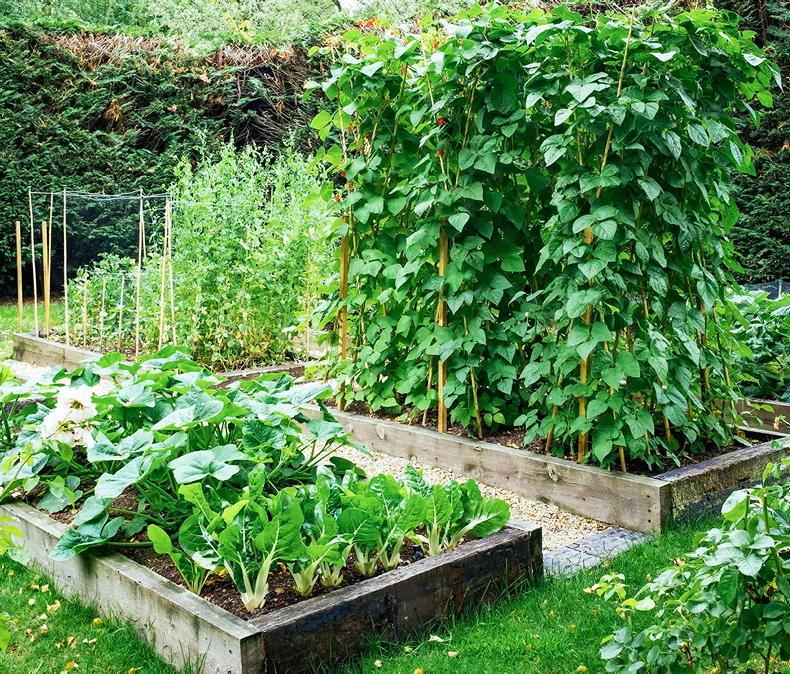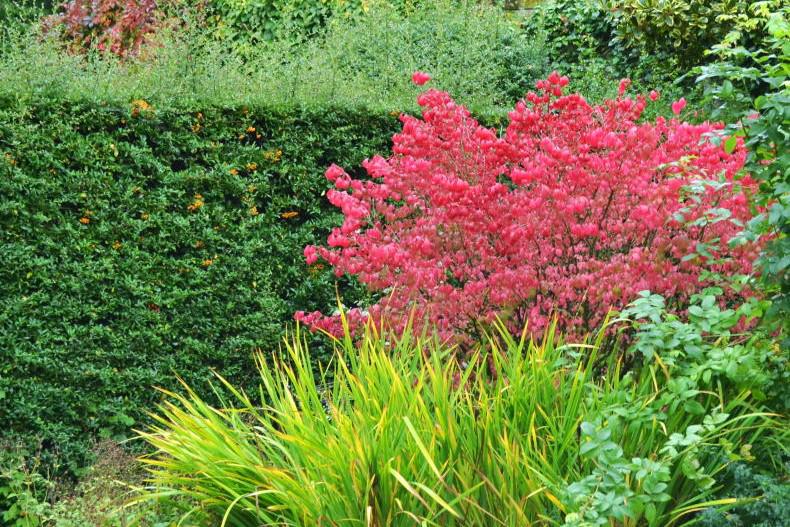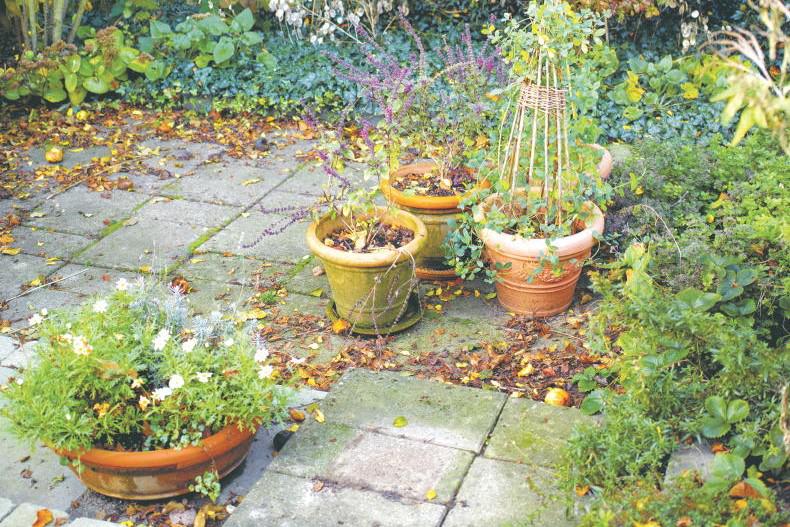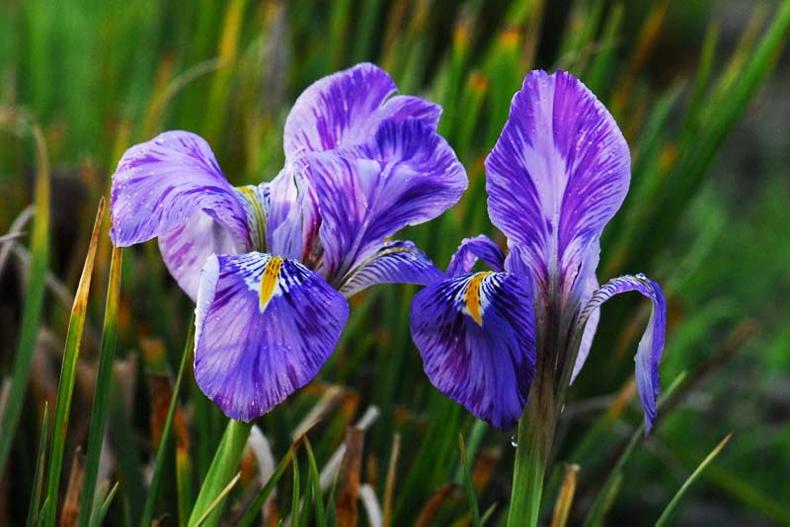Name: Reticulata irises
Botanical name: Iris reticulata and Iris danfordiae
Family: The iris is the type species of its own family, the Iridaceae. The beautiful shape of the flowers is very distinctive with three standard petals and three falls that hang down.
Iris is the Latin name for this wonderful genus of flowering rhizomes and bulbs, derived from the Greek name for the rainbow and this flower has a remarkable colour palette. The word reticulata means like a small net or mesh and it refers to the net-like membrane that wraps itself around the iris bulbs, the reticulata group being one of the bulbous irises. The species danfordiae, named in honour of Robert Danforth, an American botanist of the nineteenth century.
Garden value
These small species, Iris reticulata and Iris danfordiae, are truly remarkable, the flowers being bigger than the rest of the plant flowering time, measuring 10 to 15cm and almost as wide. Later in spring, the leaves grow out and out-weigh the flowers which by then have withered. These species are native to parts of Turkey and near the Caspian sea. This area is home to many species, notably tulips. To exist as a bulb suits these plants because they must cope with cold winters when snow storms move south from the continent to the north.
There are not many plants in flower in late winter and early spring and it is good to take advantage of everything available. The irises flowering so early are a good example of a useful plant early in the year and of course it is joined by snowdrops, crocuses, chionodoxa and early-flowering daffodils and tulips. To be successful with dwarf irises, it is useful to have an understanding of the conditions in which they were selected by evolutionary forces.
For a tiny plant that looks so delicate that it might be swept away by even a light frost, this is not the case. It is capable of surviving any frost this country can offer. However, although frost is not its challenge, there are other challenges that it must deal with. The baking-hot summers see it resort to the tactic of withdrawing to its bulbs, which is the reason it evolved to begin with.
Growing tiny irises
These two species, and a dozen or so hybrids raised from the species usually do not survive to flower after one year. This is because the bulbs do not the climatic or soil conditions that they need for success.
The summer temperatures in Ireland are much lower than their home base and also much too damp. It is possible to plant the bulbs outdoors only in full sunshine and reasonably good shelter. The soil must have coarse sand, light gravel or horticultural grit to open it up, allowing deeper rooting. These species have a tendency to divide the bulbs and being of small size are too small to carry a flower that is relatively large. From experience, the blue flowered reticulata species is more reliable than Danford’s variety. They have a better chance when grown on a rock garden facing south.
These little irises are probably most effective when grown in pots or other containers. They can also be brought indoors in pots. When spring flowering has taken place, the plants can be moved to another location. Admittedly, the chances of success and flowering outdoors is limited. Slugs and snails can be a problem.
Soil is the medium in which homeowners can grow fruit, vegetables and herbs. A properly balanced soil contains about 50% solid material, 25% water and 25% air. The solid material is composed of sand, silt and clay. If it has too much sand, it will be light and sandy and drain very fast, while too much clay makes soil very sticky, although its nutrient levels can be good.
Traditioally, digging by hand with a spade has been the way home-growers of vegetables have tilled the soil in preparation for planting and seed sowing. And this is still the best way for most ordinary vegetable gardens. An attractive alternatve, known as the no-dig method has been developed and it does offer less digging or at least makes it easier.

Raised beds for growing vegetables in the kitchen garden.
The no-dig method works by adding more growing material to the soil surface with a series of raised beds, held in place by lengths of timber. The existing soil is covered with cardbord and over time – and the activities of eartworms – the soil underneath become mixed with the added organic material, such as garden compost, spent mushroom compost, straw or well rotted manure. However, raised beds be they conventional or of the newer no-dig method, can be quite dry and need a lot of watering.
Apart from methods of digging, a small rotavator an take away a lot of the work. These machines are also useful for working in organic material before sowing. Up to a 5cm layer of good compost can be worked in each spring. At this rate it will generally not be necessary to use any other plant feeds. Digging can be carried out in late autumn, winter and spring. Rotavation is generally best done a couple of weeks before first sowing in March or April.
Trees, shrubs and roses
Bush roses and repeat-flowering climbers should be pruned, in the next two weeks if not already done. The deciduous tree planting season still has a while to run and this is a good time to plant if the ground is not too wet.
Flowers
Lifting and dividing of over-grown herbaceous flowers can continue if the soil is dry enough. Old flower stems can be tidied away or they can be left on the soil surface as a mulch.
Lawn
The lawn areas should be mown as early as possible in the year. Do not cut down too far, perhaps one notch up on the usual level. The grass grows a little over winter and the sward can be very heavy.
Fruit, vegetables and herbs
Take any weather opportunity to prepare ground for vegetables. A wide range of tree and bush fruits is available and many good varieties are on offer. Plant garlic if the ground is open. Sow seeds of early varieties.
Greenhouse and house plants
Greenhouse peach trees should have the first flowers gently pollinated with a small soft paintbrush or by vigorously tapping on the support wires. Grape vines should be pruned without delay.
Read more
Kitchen Garden Series Part 1 and Wonderful Witch Hazel: Gardening with Gerry
Mary Keenan’s Garden Diary: break for the border
Name: Reticulata irises
Botanical name: Iris reticulata and Iris danfordiae
Family: The iris is the type species of its own family, the Iridaceae. The beautiful shape of the flowers is very distinctive with three standard petals and three falls that hang down.
Iris is the Latin name for this wonderful genus of flowering rhizomes and bulbs, derived from the Greek name for the rainbow and this flower has a remarkable colour palette. The word reticulata means like a small net or mesh and it refers to the net-like membrane that wraps itself around the iris bulbs, the reticulata group being one of the bulbous irises. The species danfordiae, named in honour of Robert Danforth, an American botanist of the nineteenth century.
Garden value
These small species, Iris reticulata and Iris danfordiae, are truly remarkable, the flowers being bigger than the rest of the plant flowering time, measuring 10 to 15cm and almost as wide. Later in spring, the leaves grow out and out-weigh the flowers which by then have withered. These species are native to parts of Turkey and near the Caspian sea. This area is home to many species, notably tulips. To exist as a bulb suits these plants because they must cope with cold winters when snow storms move south from the continent to the north.
There are not many plants in flower in late winter and early spring and it is good to take advantage of everything available. The irises flowering so early are a good example of a useful plant early in the year and of course it is joined by snowdrops, crocuses, chionodoxa and early-flowering daffodils and tulips. To be successful with dwarf irises, it is useful to have an understanding of the conditions in which they were selected by evolutionary forces.
For a tiny plant that looks so delicate that it might be swept away by even a light frost, this is not the case. It is capable of surviving any frost this country can offer. However, although frost is not its challenge, there are other challenges that it must deal with. The baking-hot summers see it resort to the tactic of withdrawing to its bulbs, which is the reason it evolved to begin with.
Growing tiny irises
These two species, and a dozen or so hybrids raised from the species usually do not survive to flower after one year. This is because the bulbs do not the climatic or soil conditions that they need for success.
The summer temperatures in Ireland are much lower than their home base and also much too damp. It is possible to plant the bulbs outdoors only in full sunshine and reasonably good shelter. The soil must have coarse sand, light gravel or horticultural grit to open it up, allowing deeper rooting. These species have a tendency to divide the bulbs and being of small size are too small to carry a flower that is relatively large. From experience, the blue flowered reticulata species is more reliable than Danford’s variety. They have a better chance when grown on a rock garden facing south.
These little irises are probably most effective when grown in pots or other containers. They can also be brought indoors in pots. When spring flowering has taken place, the plants can be moved to another location. Admittedly, the chances of success and flowering outdoors is limited. Slugs and snails can be a problem.
Soil is the medium in which homeowners can grow fruit, vegetables and herbs. A properly balanced soil contains about 50% solid material, 25% water and 25% air. The solid material is composed of sand, silt and clay. If it has too much sand, it will be light and sandy and drain very fast, while too much clay makes soil very sticky, although its nutrient levels can be good.
Traditioally, digging by hand with a spade has been the way home-growers of vegetables have tilled the soil in preparation for planting and seed sowing. And this is still the best way for most ordinary vegetable gardens. An attractive alternatve, known as the no-dig method has been developed and it does offer less digging or at least makes it easier.

Raised beds for growing vegetables in the kitchen garden.
The no-dig method works by adding more growing material to the soil surface with a series of raised beds, held in place by lengths of timber. The existing soil is covered with cardbord and over time – and the activities of eartworms – the soil underneath become mixed with the added organic material, such as garden compost, spent mushroom compost, straw or well rotted manure. However, raised beds be they conventional or of the newer no-dig method, can be quite dry and need a lot of watering.
Apart from methods of digging, a small rotavator an take away a lot of the work. These machines are also useful for working in organic material before sowing. Up to a 5cm layer of good compost can be worked in each spring. At this rate it will generally not be necessary to use any other plant feeds. Digging can be carried out in late autumn, winter and spring. Rotavation is generally best done a couple of weeks before first sowing in March or April.
Trees, shrubs and roses
Bush roses and repeat-flowering climbers should be pruned, in the next two weeks if not already done. The deciduous tree planting season still has a while to run and this is a good time to plant if the ground is not too wet.
Flowers
Lifting and dividing of over-grown herbaceous flowers can continue if the soil is dry enough. Old flower stems can be tidied away or they can be left on the soil surface as a mulch.
Lawn
The lawn areas should be mown as early as possible in the year. Do not cut down too far, perhaps one notch up on the usual level. The grass grows a little over winter and the sward can be very heavy.
Fruit, vegetables and herbs
Take any weather opportunity to prepare ground for vegetables. A wide range of tree and bush fruits is available and many good varieties are on offer. Plant garlic if the ground is open. Sow seeds of early varieties.
Greenhouse and house plants
Greenhouse peach trees should have the first flowers gently pollinated with a small soft paintbrush or by vigorously tapping on the support wires. Grape vines should be pruned without delay.
Read more
Kitchen Garden Series Part 1 and Wonderful Witch Hazel: Gardening with Gerry
Mary Keenan’s Garden Diary: break for the border










SHARING OPTIONS